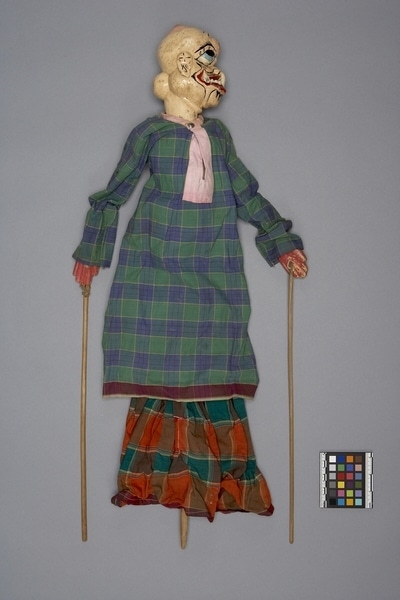Rod Puppet Item Number: Ib338 a-c from the MOA: University of British Columbia


Description
Three-dimensional male humanoid puppet: large head (part b) fits into body with skirt (part a), and a control rod (part c) with a long shaft passes through the body and fits into the neck of the figure's head. The body has jointed arms, each with a long controlling rod attached. Pinky-beige coloured face, large upward looking eyes with black pupils and blue irises, scant black beard, short blunt nose. Visible lower teeth with three fangs protruding from centre and either side of lower jaw. Bumps on forehead and top of head with circles of red, pink, and light pink; large round bump on back of neck with smaller bumps on either side. Head bald. Head detachable and joined to body by controlling rod with carved grip. Body and arms completely covered by long dress; unpainted round torso. Arms jointed at shoulder and elbow with string; hands tied to controlling wands; pink forearms and hands with fingers straight and parallel to arms. Green, blue, yellow, and dark red plaid dress with pink trim at neck and front opening and secured by tack to upper torso at neck. Orange, brown, green, dark red and yellow plaid skirt extending below dress.
History Of Use
Javanese puppetry as an art form probably developed by the 11th century. The three-dimensional wooden wayang golek puppets of western Java appeared during the 16th century. Originally the plays depicted Javanese mythology, but after the Indian conquest of Java the Hindu epics, Ramayana and Mahabharata, were incorporated into the cycles, which comprise about 200 plays. An individual or group hires a dalang (puppet-master) to celebrate important occasions. The performances often last all night and are generally presented in three acts, with vocal and instrumental accompaniment. The individual plays vary widely in detail but usually involve conflict between good and evil. They serve a moral and religious purpose, and more recently, one of political commentary. Each puppet's character is represented by its appearance and placement onstage; protagonists with strong elements of good are placed to the right, antagonists of violent or evil nature to the left. Semar and the other members of the punakawan are thought to be remnants form the pre-Hindu Javanese mythology. Semar is a considered to be an aspect of Ismaya, protector of the islands of Java. The clowns provide levity in the plays, a feature not typically present in the austere epics upon which they are based. They are also the only characters to make political or topical comments outside of the general scope of the plays. The Punakawan appear on the right with the good characters; in some rare cases they are themselves heroes. Their 'evil' traits are manifested in their tendency to ridicule or parody their noble masters. The features also serve to show the ambiguous nature of conflict between good and evil.
Cultural Context
Theatrical performance.
Iconographic Meaning
Large lump on rear of neck a characteristic peculiar to the Punakawan, or clown class of puppets. Bump on forehead, projecting teeth in lower jaw and small nose probably indicate Semar is the eldest and father of the other Punakawan. The body does not have features normally found with Semar. Large eyes and teeth and the bumps on the head are coarse traits which resulted from curse and changed into a misshapen dwarf.
Item History
- Made in Java, Indonesia
- Owned by Tradewind Antiques before March 15, 1983
- Received from Museum of Anthropology Shop Volunteers (Funding source) and Tradewind Antiques (Seller) on March 15, 1983
What
- Name
- Rod Puppet
- Identification Number
- Ib338 a-c
- Type of Item
- puppet
- Material
- wood, cotton fibre, paint, metal and fibre
- Manufacturing Technique
- carved, painted, machine woven, machine sewn, nailed and tied
- Part A
- height 62.5 cm, width 20.0 cm, depth 9.0 cm
- Part B
- height 14.5 cm, width 9.5 cm, depth 10.3 cm
- Part C
- height 44.5 cm, width 2.4 cm, depth 1.8 cm
Who
- Culture
- Sundanese
- Previous Owner
- Tradewind Antiques
- Received from
- Museum of Anthropology Shop Volunteers (Funding source) and Tradewind Antiques (Seller)
Where
- Holding Institution
- MOA: University of British Columbia
- Made in
- Java, Indonesia
When
- Ownership Date
- before March 15, 1983
- Acquisition Date
- on March 15, 1983
Other
- Condition
- fair
- Current Location
- Case 61
- Accession Number
- 0886/0072 a-c